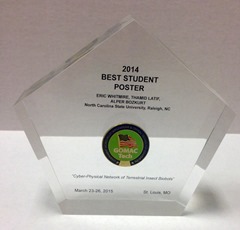![]()
Eric Whitmire, Tahmid Latif and their research advisor Dr. Alper Bozkurt have been awarded the Best Student Poster Paper Award for their paper titled “Cyber-physical Network of Terrestrial Insect Biobots,” and presented at the 39th Annual GOMACTech Conference, Charleston, SC on March 31-April 3, 2014.
The award was formally received by Dr. Bozkurt on behalf of our students during the 40th Annual GOMACTech Conference held on March 23-26, 2015 in St. Louis, MO.
The Government Microcircuit Applications & Critical Technology Conference (GOMACTech) is the premier forum for reporting on government funded micro and nano-electronic research and complementary efforts that focus on the technology needs of government systems. Established in 1968, the conference has focused on advances in systems being developed by the Department of Defense and other government agencies and has been used to announce major government microelectronics initiatives such as VHSIC and MIMIC, and provides a forum for government reviews.
The paper selection process included the poll from the conference participants from the following organizations: Department of Defense (Army, Navy, Air Force),National Aeronautics and Space Administration (NASA), Department of Commerce (National Institute of Standards and Technology), Department of Energy (Sandia National Laboratories), Department of Energy (National Nuclear Security Administration), Defense Logistics Agency, Department of Health and Human Services, Defense Threat Reduction Agency, Defense Advanced Research Projects Agency (DARPA), Advisory Group on Electron Devices, National Reconnaissance Office.
The paper description is as follows:
“Cyber-physical Network of Terrestrial Insect Biobots”
Authors: Eric Whitmire, Tahmid Latif and Dr. Alper Bozkurt
Abstract: Advances in neural engineering have enabled direct control of insect locomotion. Our previous experimentation has demonstrated control of Madagascar hissing cockroaches in line following exercises using a Kinect-based computer vision platform. In this paper, we demonstrate maze solving capabilities and the ability to localize a sound using an insect-mounted microphone array with an ultimate goal of searching for surviving victims under the rubble after natural disasters.
